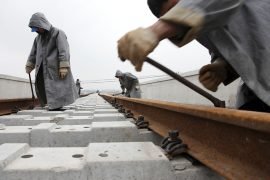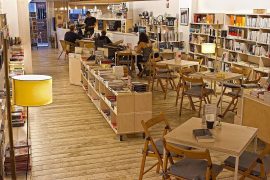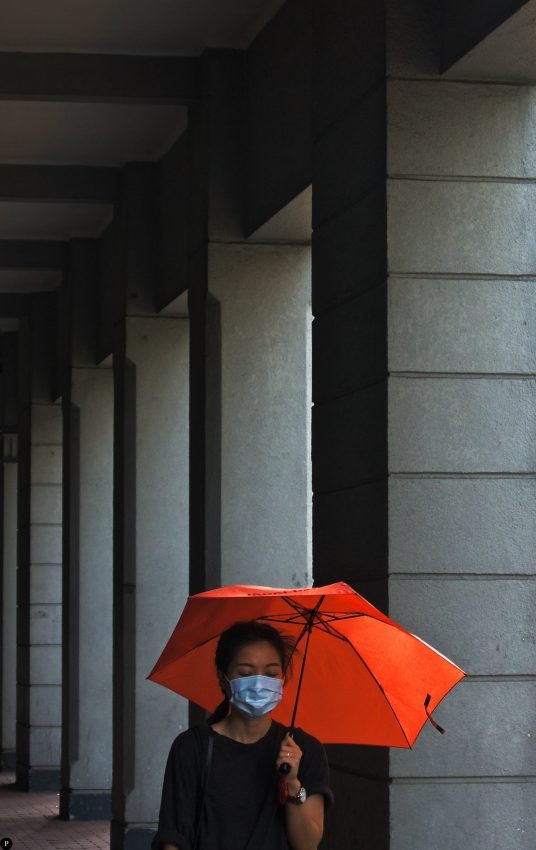[dropcap letter=”A”]
t first, it was like a whisper. Then it set itself apart from the usual excited and exhausted chatter in Spanish and Catalan that is typically found on the metro in Barcelona, mixing with the noise of rumbling trains, squeaking engines and doors closing. Some minutes before arriving in one of Barcelona’s allegedly most famous neighbourhoods, its face was already showing when two women in their early twenties sat down across from me on the train.
Poblenou was transformed from being a former industrial centre to a showpiece of the startup scene in Barcelona. As part of the 1992 Olympic revamp happening across the city, the district – nicknamed Catalan Manchester – that used to house warehouses and industrial factories began to change its face
 Wearing ripped jeans, baggy wool jumpers in bright colours and feather earrings, they talked loudly in American English. They were not tourists; there was no nervous clutching of the bag or tired expression in their faces. They seemed at ease and feeling comfortable, like they knew their way around. They got off at Llacuna station, clutching their self-made cigarettes, together with a couple of men in suits, an elderly lady with a shopping trolley, a mid-40s guy in worn-out work clothes – and me, a new-in-town journalist who wants to know what all the fuss is about. Welcome to El Poblenou.
Wearing ripped jeans, baggy wool jumpers in bright colours and feather earrings, they talked loudly in American English. They were not tourists; there was no nervous clutching of the bag or tired expression in their faces. They seemed at ease and feeling comfortable, like they knew their way around. They got off at Llacuna station, clutching their self-made cigarettes, together with a couple of men in suits, an elderly lady with a shopping trolley, a mid-40s guy in worn-out work clothes – and me, a new-in-town journalist who wants to know what all the fuss is about. Welcome to El Poblenou.
It was a sunny December morning, when I arrived in El Poblenou, a neighbourhood squeezed between the busy Avinguda Diagonal and the beach Bogatell. The area with its around 33.000 inhabitants is part of the district Sant Martí and was transformed from being a former industrial centre to a showpiece of the startup scene in Barcelona. As part of the 1992 Olympic revamp happening across the city, the district – nicknamed Catalan Manchester – that used to house warehouses and industrial factories began to change its face.
In 2000, the Barcelona government approved the plan for what is today known as 22@, a project to increase the value of and refurbish the area, building houses as well as office spaces. The aim was to “turn Poblenou into an important scientific, technological and cultural platform”, attracting international and local companies to settle down in the neighbourhood.
Every now and then, I walk past a group of are presumably office workers chatting in English, German, French – and sometimes Spanish.
When walking through the sunshine down the quiet roads of the neighbourhood almost twenty years later, I pass plenty of offices. Nowadays, the area is famous for housing startups like delivery service Glovo, co-working spaces such as the international unicorn Wework or local competitor Valkiria as well as research and development centres or offices of established corporations such as Vodafone or Amazon.
There are hardly any people on the streets, however, the drilling and hammering sounds of the building sites cut through the weird stillness of what I assumed to be a rather busy area. But that might change in the afternoon or evening. Every now and then, I walk past a group of are presumably office workers chatting in English, German, French – and sometimes Spanish.
“Barcelona reminds me of a young San Francisco”, the founder, who grew up in the Bay area in California, says. But the city needs to be careful how it continues to develop and needs “to care for all non-tech community members”
It is this internationality that Eloi Alcaide, Chief Marketing Officer at Codeworks, likes about the neighbourhood. Codeworks is an academy that teaches students to code in organised bootcamps ad has been in the area since it started in September 2016. “The scene is definitely growing and the neighbourhood changing”, Alcaide says, referring to the construction sites across the area and the transforming buildings. According to him, there is a lot of collaboration between the different companies in the neighbourhood, for example meet-ups or shared projects. “It creates a great atmosphere and you can feel the tech scene!”, he insists. While he welcomes the fact that there are a lot of expats living in the neighbourhood, he also is wary: “An international atmosphere is awesome – as long as the locals are not pushed out.”
In a different corner of Poblenou, across the street from one of those building sites and squeezed next to a large glass building that houses the Spanish technology company Zemsania, I am entering Spaces. Being originally headquartered in Amsterdam, the company rents office space or desks in its co-working spaces to companies such as Ticketmaster or solo entrepreneurs.
It is here that I meet Katrina Walker, a US-American who recently started her own company in Barcelona. She chose to live and work in Poblenou because of its creativity and the innovative atmosphere. “Barcelona reminds me of a young San Francisco”, the founder, who grew up in the Bay area in California, says. But the city needs to be careful how it continues to develop and needs “to care for all non-tech community members”, the American adds, referring to the fact that the nearby Silicon Valley’s rise and popularity throughout the years has the city suffer from a dramatic housing shortage and a rise in inequality.
It might be a similar thought that caused the 22@ project in Poblenou to currently be under review by the regional government. According to local media reports such as El Pais, mayor Ada Colau is considering to create more housing and focus less on office spaces in some parts of the project area, which in this case is North of Avinguda Diagonal.
Today, I do not walk towards the other side of the road cutting through the district. Staying on the once gritty – and maybe wild – sea-side, I walk past the much discussed offices, hidden away in loft-like spaces that look like they might have been factories in a previous life. Strolling past auto mechanics and old two- or three-story houses whose ground floors are occupied by one of the many eateries or shops selling paintings or arty clothing, I notice people pushing shopping carts full of wood pieces, rubbish and scrap metal. They push past shiny, tall glass buildings and past crumbling facades decorated with graffiti or other art works that are sometimes clever, sometimes just colourful. Welcome to El Poblenou.



















